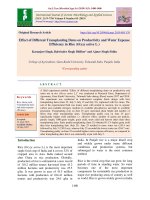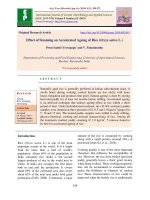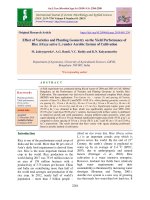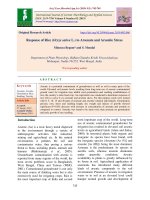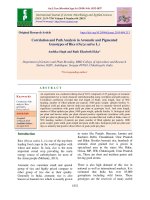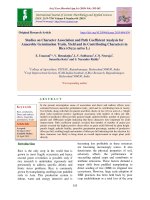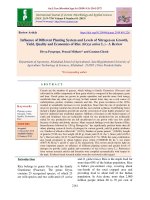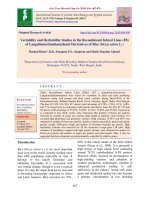Foliar response of chemicals on yield and yield attributing characters of rice (Oryza sativa L.) under rain fed condition
Bạn đang xem bản rút gọn của tài liệu. Xem và tải ngay bản đầy đủ của tài liệu tại đây (251.95 KB, 7 trang )
Int.J.Curr.Microbiol.App.Sci (2019) 8(2): 2756-2762
International Journal of Current Microbiology and Applied Sciences
ISSN: 2319-7706 Volume 8 Number 02 (2019)
Journal homepage:
Original Research Article
/>
Foliar Response of Chemicals on yield and yield Attributing Characters of
Rice (Oryza sativa L.) under Rain Fed Condition
Vikas Yadav*, Mayank Pratap, A.H. Khan, R.K. Yadav and Rajneesh
Department of Crop Physiology, Narendra Deva University of Agriculture and Technology,
(Kumarganj), Faizabad-224 229 (Uttar Pradesh) India
*Corresponding author
ABSTRACT
Keywords
Rice, Rain fed,
Chemicals and yield
Article Info
Accepted:
20 January 2019
Available Online:
10 February 2019
The present investigation entitled “Foliar Response of Chemicals on Yield and Yield
Attributing Characters of rice (Oryza sativa L.) Under Rain fed Condition” was conducted
during the Kharif season in 2016 at the Student Instructional Farm of Narendra Deva
University of Agriculture and Technology, Kumarganj, Faizabad-224 229 (U.P.).
Experiment was conducted in randomized block design with three replications and nine
treatments on rice variety (Sahbhagidhan) under rainfed condition. Chemicals viz., foliar
spray of 0.5 and 1.0%KCl, 1.0 and 2.0% MgSO4, 0.3 and 0.6% Boric acid and 0.25 and
0.5% Salicylic acid at two growth stages(15 DAT and milky stage) along with untreated
control (distilled water spray). Yield and yield attributing characters viz., Number of
panicle bearing tiller plant-1, Number of grains panicle-1, Number of sterile grains panicle -1,
Grain yield (kg ha-1), Straw yield (kg ha-1) and Test weight (g)were improved by different
chemical concentrations. On the basis of results obtained foliar application of various
chemicals enhanced yield as compare to control under rain fed condition. The effects of
1.0 % MgSO4 were more pronounced fallowed by salicylic acid 0.25 and 0.5% as well as
1% KCl over other treatments.
Introduction
Rice (Oryza sativa L.) as one of most
important cereals worldwide is considered as
the major food of more than 2 billion of
peoples across the world (Akhgary, 2004).
The rice is one of economically important
crops in the world (Bajaj and Mohanty, 2005;
Harkamal et al., 2007) which is cultivated in
114 countries (FAO, 2004).
Rice is staple food of a millions of people in
the world particularly in developing countries.
About 90 per cent of rice grown in the world
is produced and consumed in Asian countries
(Patel et al., 2016). India rank first in respect
of area (44.50 million ha) second in
production (102.75 million tonnes), but the
productivity of rice is very low (2.20 t ha-1)
(Verma et al., 2015).
Rice has the evolutionary particularity of
being semi-aquatic. The conventional system
for irrigating rice is to flood, which provides
water and nutrient supply under anaerobic
conditions and uses large amounts of water.
2756
Int.J.Curr.Microbiol.App.Sci (2019) 8(2): 2756-2762
However, about half of the rice area in the
world does not have sufficient water to
maintain flooded conditions, and yield is
therefore reduced, to some extent, by drought.
Even intermittent water stress at critical
stages may result in considerable yield
reduction and crop failure (Bernier et al.,
2008). Indeed, drought is a major limitation
for rice production in rain fed ecosystems. It
is not simply the lack of water that lowers
yield potential, but also the timing and
duration of drought stress related to
phenological processes.
In addition to these environmental problems,
a challenge for modern sustainable rice
production is to decrease the amount of water
used in rice production while maintaining or
increasing the rice yield. However, rice itself
has relatively few adaptations to water-limited
conditions and is extremely sensitive to
drought stress (Kamoshitaet al., 2008).
Foliar spraying of microelements is very
beneficial to absorb nutrients (Torun et al.,
2001; Parinaz et al., 2012). Several studies
showed
that
foliar
application
of
micronutrients on wheat crop has positive
effects on crop yield parameters (Nadim et
al., 2012; Masoudet al., 2012). The function
of macronutrients and micronutrients is vital
in crop nutrition for improved yield and
quality (Saeed et al., 2012).
In field experiments conducted in Egypt, it
was found that decreases in grain yield
resulting from restricted irrigation could be
greatly eliminated by increasing potassium
(K) supply (Abd El-Hadi et al., 1997). In
view of these results, it can be concluded that
improvement in K nutritional status of plants
seems to be of great importance for sustaining
high yields under rain fed conditions. Possible
mechanisms
helpful
in
minimizing
detrimental effects of drought by improving
water use efficiency in crop plants with K
nutrition were described by Waraich et al.,
(2011). Under water-deficit conditions, K
nutrition increases crop tolerance to water
stress by utilizing the soil moisture more
efficiently than in K-deficient plants.
Magnesium increases the root growth and
root surface area which helps to increase
uptake of water and nutrients by root and
transport of sucrose from leaves to roots.
Magnesium improves CHO translocation by
increasing phloem export and reduces ROS
generation and photo-oxidative damage to
chloroplast under drought conditions.
Boron (B) is an essential nutrient for normal
growth of higher plants and its availability in
soil and irrigation water is an important
determinant of agricultural production
(Saleem et al., 2011). Boron is responsible for
better pollination, seed setting and grain
formation in different rice varieties (Aslam et
al., 2002; Rehman et al., 2012), making it
more important during the reproductive stage
as compare to the vegetative stage of the crop.
Boron deficiency causes different effects on
very diverse processes in vascular plants such
as root elongation, in dole acetic acid oxidase
activity, sugar translocation, carbohydrate
metabolism, nucleic acid synthesis, and pollen
tube growth (Goldbach and Wimmer, 2007;
Saleem et al., 2011). Seed and grain
production are reduced with low boron supply
still in the absence of any observable
indication of deficiency symptoms and so the
requirement of B for reproductive increase
appears to be more for reproductive
development than for vegetative growth
(Nalini et al., 2013).
Salicylic acid (SA), a phenolic compound, is
associated with stress tolerance in plants.
Previous studies report that SA can induce
tolerance against high and low temperatures,
drought, salinity, ultraviolet light, heavy
metal toxicity, diseases and pathogens (Hayat
2757
Int.J.Curr.Microbiol.App.Sci (2019) 8(2): 2756-2762
and Ahmad, 2007; Horváth et al., 2007;
Hussain et al., 2008). Moreover, there is
evidence that exogenous application of SA
can alter antioxidant capacity in plants (Rao et
al., 1997), thereby providing protection
against oxidative damage (Larkindale and
Huang 2004), there by inducing stress
tolerance.
Number of panicle bearing tillers plant-1,
Number of grains panicle-1, Number of fertile
grains panicle-1, Number of sterile grains
panicle-1, Test weight (g), Straw yield
(kg ha-1) and Grain yield (kg ha-1) were taken
at the time of harvesting.
Materials and Methods
Yield and Yield attributing characters
The field experiments were carried out at
main campus of Narendra Deva University of
Agriculture and Technology, Kumarganj,
Faizabad (U.P), India on Raibareilly road at
distance of 42 km away from the Faizabad
district head quarter. The Geographically the
situation of Faizabad district lies between a
latitude of 24.470 and 26.560 North and
longitude of 18.120 and 83.900 east, on
altitude of 113 meter about mean sea level in
the Gangatic plain zone of eastern Uttar
Pradesh. The experimental site was typical
rainfed having sandy loam soil with pH 7.8,
electrical conductivity 0.60 dS/m, organic
carbon 0.56%, available nitrogen 126.4 kg/ha,
available phosphorous 18 kg/ha, and available
potassium 210 kg/ha. The total rainfall was
652.3 mm during crop growth periods (June
to October) in 2016. The experiments were
laid out in a randomized block design with
three replications. Nursery was raised from
normal soil and transplanted after twenty one
days old seedlings with two seedlings per hill
and spacing was kept 20 x 15 cm in plot size
3 x 4 m2 in three replications. Nitrogen,
Phosphorus and Potash were applied in
transplanted field at the rate of 120:60:60 kg
ha-1 in the form of urea, single super
phosphate and murate of potash, respectively.
Foliar applications of KCl (0.5 and 1.0%),
MgSO4 (1.0 and 2.0%), Boric acid (0.3 and
0.6%) and Salicylic acid (0.25 and 0.5%)
were applied at vegetative and milky stage.
Observations on yield and yield attributes viz.,
Yield is the culmination of several
comprehensive phases which starts at
germination and end at harvest, encompassing
through shoot growth, leaf development,
photosynthesis, flowering, pollination and
seed set. Better vegetative growth of a crop is
largely responsible for higher seed yield
because number of photosynthesizing sites
i.e., number of tillers is affected by initial
growth stages.
Results and Discussion
All the treatments influenced number of
panicle bearing tillers, total number of grains
panicle-1 and number of sterile grains
panicle-1 over untreated control (Table 1).
Foliar spraying of 1% MgSO4, 2% MgSO4,
0.3% Boric acid and 0.5% Salicylic acid
significantly increased number of panicle
bearing tillers plant-1, while the effect of rest
of the treatments were statistically at par with
untreated control.
Most of the treatments except 0.5% KCl
significantly increased number of total grains
panicle-1 as compared to untreated control.
Highest number of grains per panicle was
noted in case of 0.5% and 0.25%Salicylic acid
fallowed by 2% MgSO4 and 0.6% Boric acid.
All the treatments significantly reduced the
number of sterile grains panicle-1 and
minimum sterile grains panicle-1 was recorded
with 0.6 and 0.3% Boric acid fallowed by
0.25%and 0.5% Salicylic acid.
2758
Int.J.Curr.Microbiol.App.Sci (2019) 8(2): 2756-2762
Table.1 Effect of foliar application of different chemicals on yield attributes of rice at harvest
stage
Treatment
T1 – Control
T2 - 0.5 % KCl
T3 - 1.0 % KCl
T4 - 1.0 % MgSO4
T5 - 2.0 % MgSO4
T6 - 0.3 % Boricacid
T7 - 0.6 % Boricacid
T8 - 0.25 % Salicylic acid
T9 - 0.5 % Salicylic acid
SEm±
CD at 5%
No. of panicle
bearing tillers
plant-1
8.67
8.73
8.73
9.70
9.50
9.40
8.27
8.47
9.60
0.23
0.67
No. of
grains
panicle-1
145.30
147.60
151.60
152.60
153.70
151.00
153.30
154.00
154.30
1.12
3.29
No. of sterile grains
panicle-1
14.30
12.00
11.70
11.30
10.30
9.30
9.00
9.30
9.70
0.47
1.34
Table.2 Effect of foliar application of different chemicals on test weight and yield of rice
Treatment
T1 - Control
T2 - 0.5 % KCl
T3 - 1.0 % KCl
T4 - 1.0 % MgSO4
T5 - 2.0 % MgSO4
T6 - 0.3 % Boricacid
T7 - 0.6 % Boricacid
T8 - 0.25 % Salicylic acid
T9 - 0.5 % Salicylic acid
SEm±
CD at 5%
1000 grains weight
(g)
20.20
21.65
21.18
21.33
21.63
21.58
21.60
21.73
22.03
0.52
NS
Data regarding grain and straw yield per
hectare as well as 1000 grain weight are
presented (Table 2). The perusal of data
reveals that all the treatments registered
significant increase in grain yield per hectare.
However, maximum increase in grain yield
was recorded with 1% MgSO4 (3415.00 kg
ha-1) and minimum with 0.5% KCl (3080.00
kg ha-1). While in case of straw yield per
hectare and 1000 grain weight, the spraying
Grain yield (Kg ha-1)
2956.00
3080.00
3300.00
3415.00
3225.00
3250.00
3210.00
3315.00
3280.00
38.08
118.45
Straw yield
(Kg ha-1)
5142.00
5335.00
5238.00
5385.00
5375.00
5486.00
5400.00
5408.00
5351.00
0.78
NS
of chemicals did not produce significant
effect. The results are in accordance with the
findings of Raza et al., (2014) who reported
that foliar application of B significantly
affected on grain yield, number of grains
spike-1 and 1000 grains weight. Similar results
were also reported by Moghadam et al.,
(2011) that the foliar application of B and Zn
had positive effect on yield and yield
components of wheat. The enhanced wheat
2759
Int.J.Curr.Microbiol.App.Sci (2019) 8(2): 2756-2762
crop yield by B spraying at booting stage may
be due to provision of B at initial stages
which might have enhanced the accumulation
of assimilate in the grains (Arif et al., 2006).
The higher crop yield under B application is
the result of positive role of B in pollen grain
formation, pollen tube formation, grain set,
pollination, flower set and pollen grains
viability at booting stage (Subedi et al.,
1997a).
In conclusion, the results of this experiment
shows that spraying of 0.5 and 1.0 % KCl, 1.0
and 2.0 % MgSO4, 0.3 and 0.6 % Boric acid,
0.25 and 0.5 % salicylic acid significantly
increased Yield and yield attributes viz.,
panicle bearing tillers plant-1, number of
grains panicle-1, number of fertile grains
panicle-1, grain yield (kg ha-1) and straw yield
(kg ha-1). There was non-significant effect of
treatments on 1000 grains weight as compare
to control.
This study show the importance of
micronutrients and plant growth regulator on
plants that improves yield and yield
components viz., number of panicles bearing
tillers plant-1, number of grains panicle-1,
number of fertile grains panicle-1, grain yield
(kg ha-1), straw yield (kg ha-1) and 1000
grains weight. All the treatments reduced the
number of sterile grains which helped in
obtaining higher yield.
References
Abd El-Hadi, A. H., Ismail, K. M. and ElAkahawy, M. A. (1997). Effect of
potassium on the drought resistance of
crops in Egyptian conditions, In
Johnston, AE.: Food Security in the
WANA Region, the Essential Need
for Balanced Fertilization. Int. Potash
Inst Basel: 328–336.
Akhgary, H. (2004). Rice (Agriculture,
regrowth, nutrition). Rasht Islamic
Azad University's publication. 481 p,
in persion.
Arif, M., Chohan, M. A., Ali, S., Gul, R. and
Khan, S. (2006). Response of wheat to
foliar application of nutrients. J.
Agric. Soc. Sci., 1 (4): 30–34.
Aslam, M., Mahmood, I. H., Qureshi, R. H.,
Nawaz, S. and Akhtar, J. (2002).
Salinity tolerance of rice as affected
by boron nutrition. Pak. J. Soil Sci.,
21: 110−118.
Bajaj, S. and Mohanty, A. (2005). Recent
advances in rice biotechnology towards
genetically
superior
transgenic rice. Plant Biotechnology
J., 3: 275-307.
Bernier, J., Atlin, G. N., Serraj, R., Kumar,
A., and Spaner, D. (2008). Breeding
upland rice for drought resistance. J.
Sci. Food Agric., 88: 927–39.
Goldbach, H. E. and Wimmer, M. (2007)
Boron in plants and animals: Is there a
role beyond cell-wall structure?
Journal Plant Nutr. Soil Sci., 170: 39–
48.
Harkamal, W., Clyde, W., Linghe, Z.,
Abdelbagi, M. I., Pascal, C. and
Timothy, J. C. (2007). Genome wide
transcriptional analysis of salinity
stressed japonica and indica rice
genotypes during panicle initiation
stage. Plant Mol. Biol., 63: 609-623.
Hayat, S. and Ahmad, A. (2007). Salicylic
Acid – A Plant Hormone. Dordrecht:
Springer.
Horváth, E., Szalai, G. and Janda, T. (2007)
Induction of abiotic stress tolerance by
salicylic acid signaling. J Plant
Growth Regul., 26: 290-300 2007.
Hussain, M., Malik, M. A., Farooq, M.,
Ashraf, M. Y. and Cheema, M.A.
(2008). Improving drought tolerance
by
exogenous
application
of
glycinebetaine and salicylic acid in
sunflower. Journal of Agronomy and
Crop Science, 194, 193-199.
2760
Int.J.Curr.Microbiol.App.Sci (2019) 8(2): 2756-2762
Kamoshita, A., Babu, R. C., Boopathi, N. M.
and Fukai, S. (2008). Phenotypic and
genotypic analysis of droughtresistance traits for development of
rice cultivars adapted to rain fed
environments. Field Crops Res., 109:
1–23.
Larkindale, J., and Huang, B. (2004).
Thermo-tolerance and antioxidant
systems
in
Agrostisstolonifera:
Involvement of salicylic acid, abscisic
acid, calcium, hydrogen peroxide and
ethylene. Journal of Plant Physiology,
161: 405-413.
Masoud, B., Rooholla, A., Ghasem, M. N.,
Khatoon, Y. and Sayed, M. T. (2012).
Effect of different microelement
treatment on wheat (Triticum aestivum
L.) growth and yield. International
Research Journal of Applied Basic
Science, 3 (1): 219-223.
Moghaddam, N. M., Arvin, M. J., Nezhad, G.
R. K. and Maghsoudi, K. (2011).
Effect of salicylic acid on growth and
forage and grain yield of maize under
drought stress in field conditions.
[Persian]. Seed and Plant Production
Journal, 27-2 (1): 41-55.
Nadim, M. A., Awan, I. U., Baloch, M. S.,
Khan, E. A., Naveed, K. and Khan, M.
A.
(2012).Response
of
wheat
(Triticum aestivum L.) to different
micronutrients and their application
methods. J. Anim. Plant Sci., 22(1):
113-119.
NaliniPandey and Bhavana Gupta (2013). The
impact of foliar boron sprays on
reproductive biology and seed quality
of black gram. Journal of Trace
Elements in Medicine and Biology,
27: 58–64.
Parinazkohnaward, Jalal Jalilian and Alireza
Pirza (2012). Effect of foliar
application of micro-nutrients on yield
and yield components of safflower
under conventional and ecological
cropping
systems.
International
Research Journal of Applied Basic
Science, 3 (7): 1460- 1469.
Patel, T., Nayak, T. and Mishra, V. N. (2016).
Effect of different fertility levels and
nutrient uptake by drought tolerant
rice
genotypes
under
rainfed
condition. The Bioscan, 11(1):401406.
Rao, M. V., Paliyath, G., Ormrod, P., Murr,
D. P. and Watkins, C. B. (1997).
Influence of salicylic acid on H2O2
production, oxidative stress, and H2O2
metabolizing
enzymes.
Plant
Physiology, 115: 137-149.
Raza, S. A., Ali, S., Chahill, Z. S. and Iqbal,
R. M. (2014).Response of foliar
application of boron on wheat
(Triticum aestivum L) crop in
calcareous soils of Pakistan. Acad. J.
Agric. Res., 2 (3): 106-109.
Rehman, A., Farooq, M., Cheema, Z. A. and
Wahid, A. (2012). Seed priming with
boron improves growth and yield of
fine grain aromatic rice. Plant Growth
Regul, doi: 10.1007/s10725-012-97062.
Saeed, B., Gul, H., Khan, A. Z., Badshah, N.
L., Parveen, L. and Khan A (2012).
Rates and methods of nitrogen and
sulfur application influence and cost
benefit analysis of wheat. Journal of
Agricultural & Biological Science,
7(2): 81-85.
Saleem, M., Khanif, Y. M., Ishak, F.,
Samsuri, A. W. and Hafeez, B. (2011)
Importance of Boron for Agriculture
Productivity: A Review. Int Res. J.
Agric. Sci. Soil Sci. 1(8): 293-300.
Subedi, K. D., Budhathoki, C. B. and Subedi,
M. (1997a). Variation in sterility
among wheat (Triticum aestivum L.)
cultivars in response to boron
deficiency in Nepal. Euphytica, 95:
21–26.
Torun, A., ltekin, I. G. A., Kalayci, M.,
2761
Int.J.Curr.Microbiol.App.Sci (2019) 8(2): 2756-2762
Yilmaz, A., Eker, S. and Cakmak, I.
(2001). Effects of zinc fertilization on
grain yield and shoot concentrations of
zinc, boron, and phosphorus of 25
wheat cultivars grown on a zinc
deficient and boron-toxic soil. Journal
of Plant Nutrition, 24 (11): 18171829.
Verma, V. K., Meena, R. N., Gautam, A.,
Gaurav, Tyagi, V. and Kumar, A.
(2015). Effect of crop establishment
method and different source of zn on
growth, yield and quality of rice
(Oryza sativa L.). The Ecoscan. 9(3 &
4): 873-876.
Waraich, E. A., Amad, R., Ashraf, M. Y.,
Saifullah and Ahmad, M. (2011).
Improving agricultural water use
efficiency by nutrient management.
ActaAgriScandi – Soil & Plant Sci., 61
(4): 291-304.
How to cite this article:
VikasYadav, MayankPratap, A.H. Khan, R.K. Yadav and Rajneesh. 2019. Foliar Response of
Chemicals on yield and yield Attributing Characters of Rice (Oryza sativa L.) under Rain Fed
Condition. Int.J.Curr.Microbiol.App.Sci. 8(02): 2756-2762.
doi: />
2762

